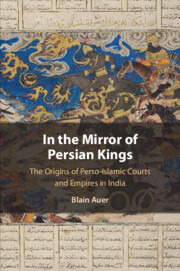Book contents
- In the Mirror of Persian Kings
- In the Mirror of Persian Kings
- Copyright page
- Dedication
- Contents
- Figures and Maps
- Maps
- Preface: In the Mirror of Persian Kings in India
- Abbreviations
- A Note on Transliteration
- 1 The History of Persian Kingship and Persianization in South Asia
- 2 Kings in History
- 3 Warrior King
- 4 Theory and Application of Persianate Political Ethics in India
- 5 The Pen, the Sword, and the Vizier
- Conclusion
- Bibliography
- Index
3 - Warrior King
Slaying Demons, Hunting Beasts, and War
Published online by Cambridge University Press: 17 April 2021
- In the Mirror of Persian Kings
- In the Mirror of Persian Kings
- Copyright page
- Dedication
- Contents
- Figures and Maps
- Maps
- Preface: In the Mirror of Persian Kings in India
- Abbreviations
- A Note on Transliteration
- 1 The History of Persian Kingship and Persianization in South Asia
- 2 Kings in History
- 3 Warrior King
- 4 Theory and Application of Persianate Political Ethics in India
- 5 The Pen, the Sword, and the Vizier
- Conclusion
- Bibliography
- Index
Summary
The image of the Persian king is of a leader who rules the known world with justice and safe-keeping. The warrior aspect of the Persian king is the quality of the ruler to emerge victorious in battle with honor. A large part of a warrior-king’s duty was to subdue the presence of evil in the world. Persian kings and heroes of legend were tested through their conflict with the forces of chaos and savagery. In conquest, the hero demonstrated his courage and bravery by defeating monsters, devils, and ferocious beasts. Muslim intellectuals writing about the conquest of India embellished their histories with the ornamentation of Persianate heroic lore that civilized the untamed forces of nature and the demonic realm.
- Type
- Chapter
- Information
- In the Mirror of Persian KingsThe Origins of Perso-Islamic Courts and Empires in India, pp. 90 - 120Publisher: Cambridge University PressPrint publication year: 2021

